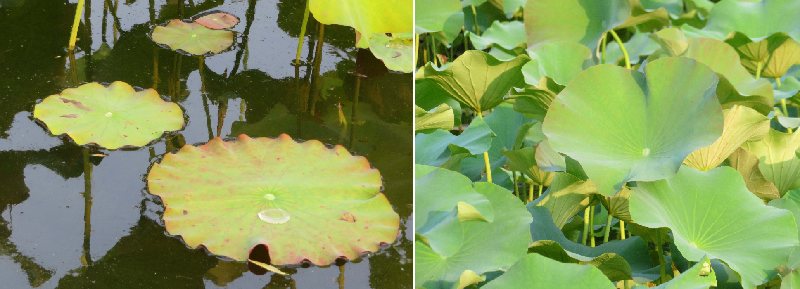Explaining the Ruffles of Lotus Leaves
In many ponds in Asia, flat, circular, lotus leaves with wrinkled edges float near other elevated stems of the same plant holding cupped leaves with gently wavy borders. Theoretical work and experiments with leaflike membranes now reveal that genetically identical leaves can grow into distinctly different shapes as a result of mechanical effects, such as the support of water under a floating leaf. The researchers extended a theory for the growth of thin, elastic tissues to account for some previously unexplored mechanical aspects of the environments of lotus and other plants. The findings bolster mounting recognition of the major role that mechanical influences play alongside genes and biochemistry in determining plant shapes.
Modeling the growth of soft tissues in plants and animals has challenged scientists and engineers because these structures deform in ways that are difficult to describe mathematically. More than 25 years ago, researchers proposed a mathematical framework to describe soft tissue growth in which proliferation of new cells takes place in tandem with stretching and shifting of existing tissues [1]. In 2008. physicists in France adapted the theory to elastic membranes (see Focus: Elizabethan Geometry) [2], providing insights into some developmental patterns of algae and mushrooms.
In 2018, mechanical engineer Fan Xu of Fudan University in Shanghai saw several different lotus leaf shapes in a pond on campus, which led him to study the shapes of growing leaves. He and his colleagues now report extending the 2008 model to produce a more complete description of the growth of thin tissues, and it accurately predicts a range of complex leaf shapes. The team used some specialized numerical techniques that allowed them to solve more complicated equations than researchers could previously manage.
Their theory incorporates two new elements: support for floating leaves from the water beneath them and the option for different leaf layers to grow at different rates, which can cause leaf bending. This second element was needed to accurately represent how leaves grow. For example, sunlight-induced growth of lotus leaves can occur faster on the side opposite the light, which tends to curve the leaf toward the sun. Related light-induced motion occurs in other plants, says Xu. “Sunflowers harness this bending effect to face the Sun.”
To supplement their calculations with experiments, the Fudan team cut leaf facsimiles from sheets of a material that grows when contacted by water. They selectively wetted the material at locations where growth in real leaves was anticipated or allowed the fake leaves to float for a prescribed duration to mimic growth constrained by underlying water. This growth-like expansion produced leaf shapes in agreement with the simulations and with observations of real leaves.
Simulations using the model, validated by observations of floating lotus leaves in the wild, showed that the water-supported leaves grow flat and largely smooth except near their edges, which have short-wavelength ruffles. In contrast, lotus leaves suspended on stems assume cupped shapes with long-wavelength undulations.
In each case, the edge waves appear because the growing leaf produces more surface area than can fit in a perfectly smooth sheet. The model favors the lowest-energy configuration, and a water-bound leaf’s short-wavelength, low-amplitude waves minimize the energy needed to lift the water that adheres to the leaf’s underside, compared with long-wavelength, high-amplitude waves. But a dry, suspended leaf is free to develop longer-wavelength oscillations that are less energetically costly in the absence of water. However, leaves with more robust stems and veins have shorter wavelengths than flimsier leaves because the stiffness also imposes an energy cost to large-amplitude waves.
For suspended leaves, different growth rates in different layers leads to a bending force that can also affect leaf shape. Under some conditions, this bending force transforms flat leaves into deep, steep-sided bowls without their characteristic waviness—another shape that has been observed in nature.
The findings by the Fudan team reflect a revival of interest in recent years in the role of mechanics—as opposed to genetics and biochemistry—in determining the shapes of biological structures, according to Ellen Kuhl, a mechanical and bioengineer at Stanford University in California. In studies of brain-tissue folding, for example, “people have always looked at just the cells,” she says, but now they’re starting to recognize the importance of mechanical forces.
This research is published in Physical Review Letters.
–Peter Weiss
Peter Weiss is a freelance science reporter and editor in Washington, D. C.
References
- E. K. Rodriguez et al., “Stress dependent finite growth in soft elastic tissues,” J. Biomech. 27, 455 (1994).
- J. Dervaux and M. Ben Amar, “Morphogenesis of growing soft tissues,” Phys. Rev. Lett. 101, 068101 (2008).







